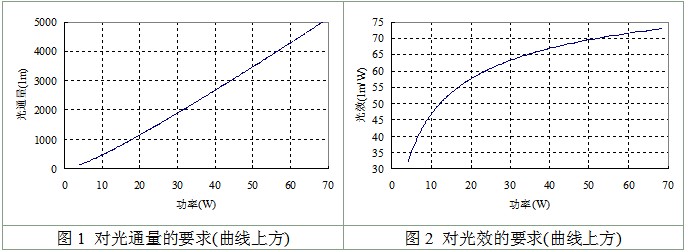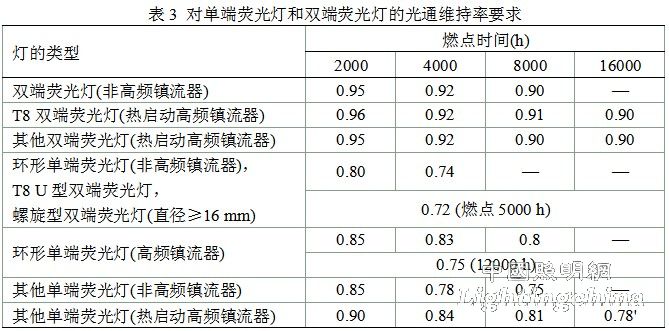1. Current status of fluorescent lamp production in China Fluorescent light has high efficiency, good color rendering, color temperature optional, small heat radiation and long life. It is the most important energy-saving lighting source and has been widely used in various indoor places. According to the statistics of China Lighting Association, the output of fluorescent lamps produced by 204 companies in China in 2009 was 5.52 billion [1]; among them, 3.88 billion compact fluorescent lamps accounted for 70%. The output and ratio of various fluorescent lamps are shown in Table 1. Since 2009, compact fluorescent lamps have replaced incandescent lamps as the most productive source of light. In 2010, China's electric light source industrial technology and equipment basically reached or approached the world's advanced level. China has become the world's largest production base and sales center for electric light source energy-saving products, manufacturing 85% of the world's compact fluorescent lamps, and has made outstanding contributions to global energy conservation and emission reduction [2]. In 2009, the National Development and Reform Commission cooperated with the United Nations Development Program (UNDP) and the Global Environment Facility (GEF) to launch the “China Phased Elimination of Incandescent Lamps and Accelerate the Promotion of Energy-Saving Lamps†project, which marked the beginning of a new phase of China's green lighting international cooperation. 3]. In the three years from 2008 to 2010, China has promoted 360 million energy-saving lamps [4]. Our country is in the process of setting a timetable for the ban on the production and sale of incandescent lamps. So far, more than 40 countries including the United States, Australia, the European Union, Canada, Japan, Russia, and India have announced that they will be phased out from 2008 to 2009 and until 2012 (individual countries until 2015). High-energy incandescent lamps. Compact fluorescent lamps have become the ideal replacement for incandescent lamps due to their compact structure, long life, cost-effective, easy to use, energy-saving and environmentally friendly features. According to data released by the US Energy Star: In 2007, the United States imported 400 million energy-saving lamps. By 2012, the United States needs 1.4 billion energy-saving lamps every year. It can be seen that compact fluorescent lamps still have a large market and development space in the next 5 to 10 years. In the past 10 years, China's compact fluorescent lamps have developed rapidly. The accumulation of capital, technology and talents in the initial stage of development has been completed, and a number of backbone enterprises for the production of compact fluorescent lamps have been formed, making it the world's largest producer of compact fluorescent lamps. In recent years, solid mercury has been gradually replaced by liquid mercury in fluorescent lamps, and the amount of mercury has been greatly reduced. The mercury-filled energy consumption of micro-mercury energy-saving lamps introduced by leading enterprises in China has dropped below 1 mg, and the environmental impact of energy-saving lamps after production, transportation and disposal has been minimized. However, it is worth noting that China's compact fluorescent lamp products have a certain gap in terms of light efficiency, longevity, consistency of product main parameters and appearance compared with products produced by multinational lighting companies. 2. The challenge of the EU Eco Directive On March 18, 2009, the European Commission officially promulgated the European Commission Regulation No. 244/2009 on the implementation of the European Parliament and Council Directive 2005/32/EC on the ecological design requirements for non-directional household lamps (hereinafter referred to as “244/2009/ECâ€) provides a phased ecological design requirement for non-directional household lamps, including compact fluorescent lamps [5, 6]. The Regulation is an important implementation measure of the EU's Framework Directive on the Ecodesign Design Requirements for Energy-Efficient Products (EuP Directive). It requires that household incandescent lamps and low-efficiency tungsten halogen lamps gradually withdraw from the EU market from September 1, 2009. At the same time, strict energy efficiency requirements are imposed on integrated compact fluorescent lamps, the main replacement for incandescent and tungsten halogen lamps. On March 24, 2009, the European Union officially announced the implementation of non-integrated ballast fluorescent lamps, high-intensity discharge lamps and ballasts and lamps that can make such lamps work. European Parliament and Council of the European Union 2005/ The eco-design requirements of Directive 32/EC and the repeal of Regulation (EC) No. 245/2009 (EC) of the European Parliament and Council Directive 2000/55/EC (Directives on Fluorescent Lamp Ballasts) (hereinafter referred to as “ 245/2009/ECâ€[7-9]. On April 24, 2010, the European Union issued the 347/2010/EU Regulations[10], which greatly revised the EU 245/2009/EC regulations. Adjustment of light effect value and performance value, and adjustment of some textual expressions. 2.1 Requirements for light efficiency (1) Integrated compact fluorescent lamp EU 244/2009/EC specifies the maximum rated power for a compact fluorescent lamp with a given nominal luminous flux Φ This is equivalent to meeting the Class A energy efficiency level in the EU's Domestic Energy Labeling Directive (98/11/EC). As the rated power of compact energy-saving lamps increases, the luminous efficacy requirements continue to increase. According to formula (1), the change in luminous flux and luminous efficiency with power is shown in Figs. 1 and 2. (2) Straight tube fluorescent lamp EU 245/2009/EC stipulates that for straight tube fluorescent lamps, the 100 h initial efficacy must meet the values ​​shown in Table 2. The national standard GB 19043-2003 "Energy efficiency limit value and energy efficiency rating of double-ended fluorescent lamps for general lighting" specifies the energy efficiency requirements of double-ended fluorescent lamps [11]. From the perspective of minimum energy efficiency requirements, the national standard is higher in the low power section (15~33 W) than in the EU T8 tubular type, and lower in the high power section (33 W and above) than the EU T8 tubular type. As far as the T5 tube type is concerned, the national standard is 10% smaller than the EU regulations on all power specifications. In addition, EU 245/2009/EC also put forward requirements for the initial light efficiency of single-ended fluorescent lamps and circular fluorescent lamps, and the single-ended fluorescent lamps are basically consistent with the national standard energy-saving evaluation values. 2.2 Requirements for lumen maintenance EU 244/2009/EC clearly stipulates the performance indicators such as the luminous flux maintenance rate of compact fluorescent lamps, and requires that the compact fluorescent lamps placed on the EU market have a burning point of 2000 from September 1, 2009 to August 31, 2013. At h, the lumen maintenance rate must reach 85%; from September 1, 2013, the lumen maintenance rate should reach 88% (flame point 2000 h) and 70% (flame point 6000 h). The EU 347/2010/EU specifies the lumen maintenance requirements for single-ended fluorescent lamps and double-ended fluorescent lamps, as shown in Table 3. China's requirements for lumen maintenance are different from those of the EU, and only the 2000 h lumen maintenance rate is not less than 80%. The EU is required to announce the lumen maintenance rate of 2000, 4000, 6000, 8000, 12000, 16000 h. And the indicator is very high than the national standard. The European Union stipulates that the 2000 h lumen maintenance rate is 0.95, which is much higher than that of China's 0.80. The straight tube fluorescent lamp requires a lumen maintenance rate of 0.90 for 16000 h, which may not be reached at the current level of domestic products. 2.3 Requirements for residual rate The EU 347,/2010/EU specifies the residual rate requirements for single-ended fluorescent lamps and double-ended fluorescent lamps, as shown in Table 4. This is a parameter that is not available in the national standard and is very demanding. The technical solution is only driven by an electronic ballast with preheating. In particular, the residual rate of a double-ended fluorescent lamp at 16000 h requires 0.90, which is not achieved without a perfect preheating design. 
 (1)
(1) 

